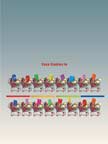Consumers Behavior
 |
Details
Chapter Code: CBC16
Textbook:
210 X 275 mm approx.
Short Case Studies
Detail Table of Contents
Workbook:
Pages : 304; Paperback;
210 X 275 mm approx
Pricing
Textbook Price: Rs. 750;
Workbook Price: Rs. 700;
Shipping & Handling Charges: Rs. 50 per book;
Books Available only in INDIA
Chapter Price : Rs. 100
To download this chapter in electronic format, click on the button below,
and select the chapter from the list of available chapters.
Buy Now
To order the entire book click on the button below, and select the book from
the list of available books:
Please allow 5 to 10 days for delivery of the
Book.
Consumer Behavior : Chapter 16
SUMMARY: Organizational buying is the process of purchase of products and services by organizations. Although, organizational buying is similar to family buying, it is significantly different on several counts. Unlike in the case of family buying, rational decision making, strong ties with the suppliers, large-scale purchases, expert purchase agents, derived demand, and reverse buying, are part of organizational buying. Organizational purchases are generally handled by internal buying centers. A buying center can have multiple participants like gatekeepers, initiators, influencers, deciders, buyers, approvers, and users. The number of participants increases in case of difficult and more complex decisions, as compared to simple and less risky decisions. Organizations generally buy products and services in three types of buying situations - straight rebuy (practically, reordering with no change in purchase terms and conditions); modified rebuy (some change in initial purchase terms and conditions); and new task (completely new purchase decision). |
|
In case of a new task, the organizational buying process involves seven stages
- problem recognition, need description, product specification, supplier and evaluation search, proposal solicitation, supplier selection, and order and post-purchase evaluation.
The organizational buying behavior is greatly influenced by the culture of the organization, which, in turn, is based on various internal (values, perceptions, and learning) and external (firmographics, national culture and government policies) factors. Organizational buying behavior is also influenced by reference groups.
Segmentation of business markets is an important tool in the hands of business marketers. Business markets can be segmented on the basis of demographics, operations, purchase-approach, situational factors, and behavioral factors.



